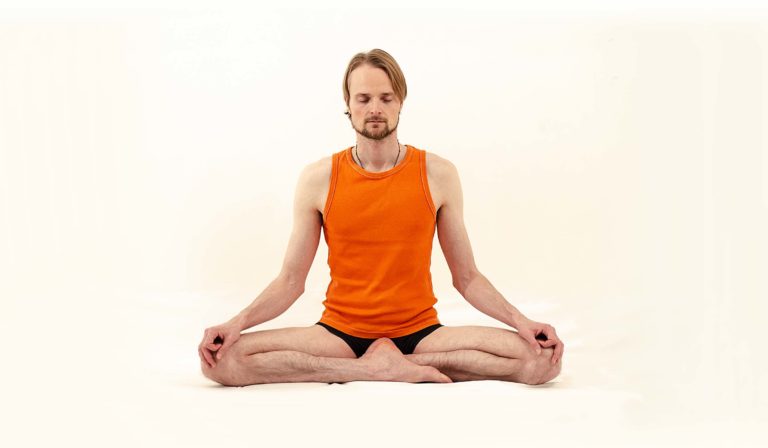For more than a decade, Mindfulness meditation has become a trendy style of meditation. But what is it really? Where does the term come from and how does it distinguish itself from other forms of meditation? As you will see in this article, the defining boundaries are blurred.
Meditation is a catch-all for contemplative techniques. For starters, meditating is sitting still with eyes closed, directing one’s attention inwards. But what the meditator actually does varies from one technique to another. During practice, the meditator uses an anchor object towards to which he directs his attention. This can be among other things the breath, a visualisation, the sounds around him or a mantra.
Dealing with distractions
The attitude one has towards distraction sets the character of the meditation. When meditating, sooner or later (often sooner) there will come a moment when the mind starts to wander. If the aim is to stay with the anchoring point and to ignore deviations, the practice will then have concentration as its main characteristic.
But the meditator can also use the deviations to become aware of the thoughts passing through his/her mind. If he allows that which distracts his attention to express itself, while observing this process, without intervention or evaluation, then the meditation takes on another feature. In this case, I would call it open awareness. According to Dr Herbert Benson, a pioneer in research on meditation, this passive attitude even is required. Otherwise it is not possible to enter the meditative state.
I like to place these two approaches on a continuum. On one extreme of the continuum, we have pure concentration techniques. On the other, we find open awareness without the support of an anchor object. One is conscious of whatever happens spontaneously, without trying to control the attention in any way.
So where would we find mindfulness meditation on this continuum?
Definitions of mindfulness
According to the researchers Richard J. Davidson and Daniel Goleman, there is confusion even in the scientific community about what mindfulness means. Even though it remains the
In an interview with the philosopher Sam Harris, Daniel Goleman defines mindfulness meditation as an attitude.
“Mindfulness, as it’s taught in the classic traditions, encourages us to take an equanimous position amidst the coming and going of our own feelings and thoughts. And to see them as feelings and thoughts rather than “that’s me”, and to just note them without judgment or without reactivity and to let them come and go.”
Daniel Goleman
For Dr Benson, this attitude is fundamental for meditation. I have myself practised in this way for 20 years without ever using the term mindfulness.
Professor of medicine John Kabat-Zinn, is the founder of Mindfulness-Based Stress Reduction (MBSR). He gives another definition :
“Mindfulness is awareness that arises from paying attention, on purpose, in the present moment and non-judgmentally.”
John Kabat-Zinn
Thus he underlines the state that is the result of the practice.
Mindfulness meditation par excellence
These definitions suggest that the mindfulness meditation par excellence would be what I call open awareness meditation. That is a meditation in which the practitioner does not make any effort to control his attention. He or she merely observes the experience that is playing out by itself.
Now we can apply the same attitude to a technique with an anchor point in the middle of the continuum described above. In this case, the “mindful moment” would be when the meditator becomes aware
Mindfulness and Sati
The Pâli word “sati” was for the first time translated as mindfulness by the British scholar Thomas William Rhys David. It originally meant to remember or to recollect, as in recollecting holy scriptures. In Theravada Buddhism, it means to maintain awareness of reality.
Pali is one of many languages spoken in India. The first Buddhist texts were written in this language.
Ancient techniques
It is the Buddhist Vipassana meditation that has inspired modern mindfulness meditations along with Tibetan Dzogchen or Mahamudra and Japanese Zen. In my tradition, a less know meditation called Antar Mauna (Inner Silence) plays the same role. As a matter of fact, most traditional meditation techniques taught today make use of the attitude described by the term mindfulness.
Mindfulness-based stress reduction – MBSR
The most common type of mindfulness meditation today is the MBSR. MBSR has been such a success that it has almost become synonymous with mindfulness. Something that seems to suit the organisations that teach it quite well. A local mindfulness school in Paris describes mindfulness like this:
“Mindfulness is the name of a meditation form of which the learning has been formalised under two protocols called MBSR and MBCT.”
MBCT is the abbreviation for Mindfulness-Based Cognitive Therapy. It is a group therapy that has also been developed by John Kabat Zinn.
MBSR was from the beginning a project at the University of Massachusetts. The goal was to treat chronic pain. Since then the project has gotten a lot of attention for the treatment of a whole range of pathologies. MBSR and similar programmes are nowadays frequently employed in schools and hospitals.
The programme stretches over eight weeks with one 2h30m – 3h30m session per week. Self-practice of one hour a day, six days a week is required.
The techniques taught in this programme are inspired by ancient ones, particularly from the tradition of the Burmese Buddhist monk Sayagyi U Ba Khin (1899-1971). The techniques also include soft yoga done in a conscious way and a whole range of other procedures. The methods are simplified and accessible. Everything that could be perceived as mysterious has been removed to make the practices appeal to Westerners.

Is mindfulness meditation taught at Forceful Tranquility?
In the tradition that I am a part of we do rarely use the term “mindfulness”. Still, its characteristical principles are integrated into our approach. Particularly in the Antar Mauna meditation.
Between MBSR and Forceful Tranquility yoga, there are some similarities but also important differences. The biggest perhaps is that MBSR is designed as an initiation for beginners. This programme, originally formulated for hospital patients is gentle, easy, therapeutic and particularly bent on stress reduction.
Forceful Tranquility yoga comes from a monastic yoga tradition. The goal is to gain deep knowledge about oneself. We use a large palette of complementary techniques, the mindfulness element being one among others. The practices are intended for particularly motivated practitioners.
Meditations that are not mindfulness, what are they?
If most meditation can be described as mindfulness meditations, then what techniques do not belong to this category?
Yoga Nidra deep-relaxation does not belong to this category. Nor Tratak. Tratak is a concentration technique though the mindfulness element is not entirely absent.
Ujjayi based meditations like the Source of Energy, other Satyananda style Ajapa Japa meditations or Kriya Yoga are not mindfulness methods. These pranayama meditations aim at awakening energy and not at cultivating awareness. The accepting attitude towards deviations is present, but only as a support.
The same goes for techniques geared towards visualisation or the practice of Metta (to radiate benevolence). Meditations based on positive thinking or suggestion does not fit into the mindfulness category either.




